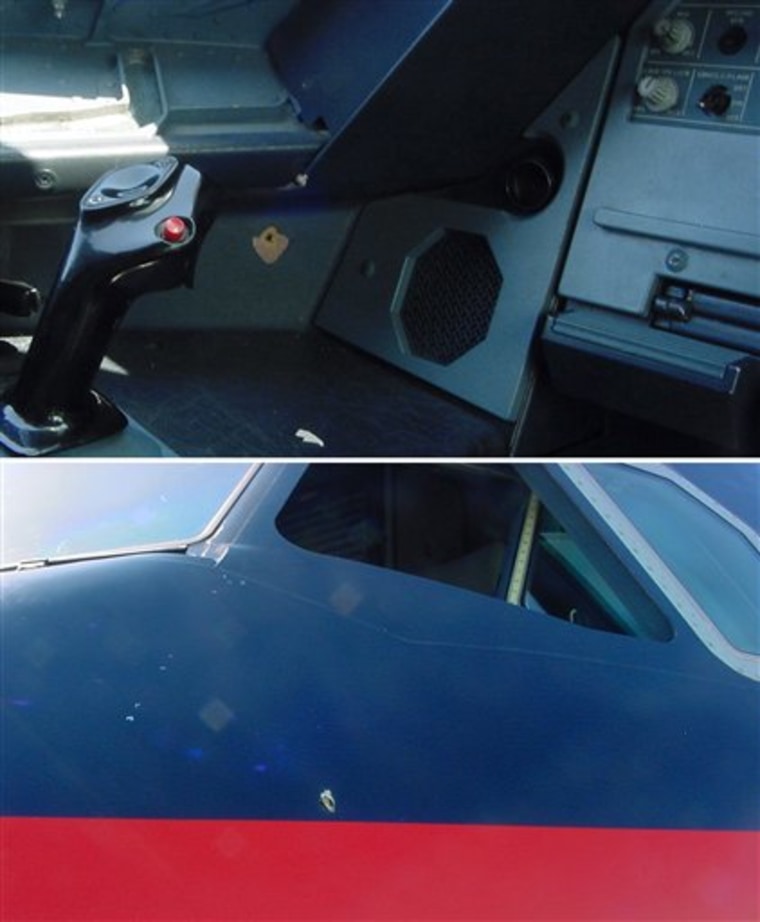The pilot of a US Airways plane may have been mishandling a firearm when it went off in flight, piercing the cockpit wall before the jet landed safely, a federal air marshal said Tuesday.
Airline officials have said the accidental discharge did not endanger the 124 passengers and five crew members over the weekend. But air safety experts said the hole, visible in photos obtained by The Associated Press, could have caused the plane to rapidly depressurize had it been in a window at a higher altitude.
All people eligible to carry guns in the cockpit carry the same weapon, the .40-caliber semiautomatic H&K USP.
"This is an extremely safe and reliable weapon," said Greg Alter of the Federal Air Marshal Service. "It's not going to discharge on its own, is the bottom line."
The pistol discharged shortly before noon Saturday aboard Flight 1536 from Denver to Charlotte, as the plane was at about 8,000 feet and was approaching to land. The photos show a small entry hole in the lower side of the cockpit wall and a small exit hole on the exterior below the cockpit window.
The AP described the photos and the bullet hole in the Airbus A319 to US Airways spokesman Phil Gee, who said "they sound authentic."
"There are two issues: would they (the crew) have enough oxygen to remain alert," said Earl Dowell, an aeronautical engineering professor at Duke University. "If the crew could no longer control the airplane, that would be a big deal. And the rapid loss of pressure might damage the structure itself."
But both Dowell and Fu-Kuo Chang, a professor of aeronautical engineering at Stanford University, said that airplane design emphasizes safety and that such a blast — even if it knocked out a window in mid-flight, isn't likely to cause the kind of damage that would lead immediately to a crash.
"If not repaired, it may cause a problem. It could get bigger. For a single bullet, it would not be a factor for the safety of the airplane," Chang said. "If it hit the window, it may be a problem for depressurization. I still don't think it would cause a crash."
Dowell pointed to a 1988 Aloha Airlines flight in Hawaii in which the roof of the jet ripped off after an explosive decompression at 24,000 feet. A flight attendant was blown out of the plane, but the passengers — many of whom were injured — remained strapped in their seats, and the pilot safely landed the aircraft.
"If they lost a window, the people near that window would have been substantially uncomfortable," Dowell said. "You probably wouldn't have crashed the airplane. But there could have been some frightened people."
The gunshot marked the first time a pilot's weapon has been fired on a plane since the flight deck officer program was created following the terrorist attacks of Sept. 11, 2001, Alter said. The Transportation Security Administration is investigating how the gun discharged, and Gee says the unidentified pilot has been taken off duty during the probe.
Pilots in the program undergo 50 hours of training at the federal Law Enforcement Training Center in Artesia, N.M. Alter said it appears the pilot of the US Airways flight wasn't following "proper procedures. ... We just don't know exactly what procedure wasn't being followed."
Since April 2003, about 5,000 flight deck officers — captains or first officers — have gone through the training program and received permission to carry weapons in the cockpit, said Capt. Bob Hesselbein, chairman of the Air Line Pilots Association's National Security Committee. The union represents more than 61,000 pilots at 43 airlines.
Gee declined to say how many US Airways pilots have graduated from the program and carry guns while on duty, citing security concerns.
But they all carry the same gun, the high-priced and high-quality H&K USP, which Alter said was specially selected for the program. Gun safety expert Ronald Scott, a ballistics expert who served for 25 years with the Massachusetts State Police, said the gun wouldn't discharge accidentally if dropped or jarred in some way.
"It's a top-of-the-line model," Scott said. "They're accurate and highly reliable. This is not something that you would just walk into a gun store and buy. And it's also not something that goes off by itself. ... Someone would have to squeeze the trigger."
The jet will be grounded at Charlotte-Douglas International Airport for several more days as repairs are made. The Federal Aviation Administration said Tuesday it won't be involved in looking at why the gun went off but will investigate to make sure the plane is safe before it returns to service.
"We want to make sure there was no structural damage and no systems on board were damaged by the bullet," said FAA spokesman Ian Gregor said. "We want to take a look at the aircraft to make sure it's in an air-worthy condition."
